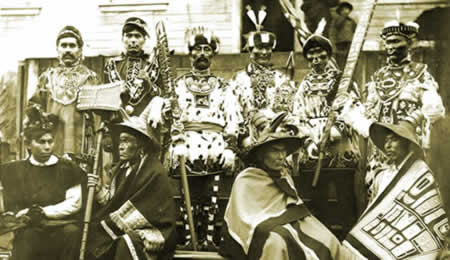Less than 3% of the population of Canada is Aboriginal, yet about 40% of the population of Canada’s prisons is Aboriginal. What do you think might be the cause of this?
Make a list of five things that you think might be factors in the over-representation of Aboriginal people in Canada's prisons.
1.
2.
3.
4.
5.
Notice how all these factors hold the person in a web of poor choices.
Traditional Aboriginal justice varied from nation to nation, however there were some common themes. What are the common themes and the different practices in traditional Aboriginal justice? What is the basic philosophy of Aboriginal justice compared to the Canadian justice system?
Aboriginal people have faced a justice system that has racism embedded in it for many, many years. Aboriginal people did not have equal rights in the law to other Canadians. They were not allowed to hire lawyers to settle land claims. Traditional ceremonies like the potlatch were made illegal. On the prairies, First Nations people would have to get permission (and a card) from their Indian agent if they wanted to travel from their reserve to a different reserve. The pass-card said where the person could travel to, and how long they could stay. The Canadian government didn’t want different reserves to organize and either make demands or war against them. It was also illegal under the Indian Act for an Aboriginal person to have any alcohol. Aboriginal people who did not speak English or French were not given translators. An Aboriginal person who only spoke their traditional language could end up in court, but not understand what was being said. Obtaining a fair trial was impossible.
Today, the numbers of Aboriginal prisoners is a serious problem - 40% of all prisoners in federal and provincial prisons are Aboriginal.
Racism aside, many of these prisoners suffer from personal histories that have thrown them into the circle you looked at above.
Problems experienced as youth | % of FN prisoners |
Parental neglect | 39.1% |
Absent parent(s) | 35.9% |
Group/foster homes | 10.9% |
Runaway | 9.4% |
Poverty | 35.9% |
Alcohol Abuse | 84.4% |
Drug use | 50% |
Learning problems | 15.6% |
Behavioural problems | 65.5% |
Emotional problems | 21.9% |
Physical abuse | 50% |
Sexual abuse | 21.9% |
Highest grade achieved | Percentage of FN prisoners. |
Grade 6 or less | 12.5% |
Grades 7-9 | 46.9% |
Grades 10-12 | 37.5% |
Post graduate | 3.1% |
Vocational Skills | Percentage of FN prisoners |
No Response | 7.8% |
Unskilled | 45.3% |
Semi-Skilled | 23.4% |
Skilled (Non-traditional skills) | 18.8% |
Craftwork/Artwork | 4.7% |
Needs of Aboriginal Inmates | Percentage of FN Prisoners |
Substance Abuse Treatment | 88% |
Personal/Emotional Counselling | 82% |
Employment Counselling | 63% |
Education and Training | 54% |
Other causes of higher arrest rates are:
- Police arresting without cause.
- Police are more likely to patrol areas of cities that have a higher Aboriginal population.
- These areas have higher poverty levels, other social problems, and higher crime rates
- This results in Aboriginal peoples being arrested for minor offences that would be overlooked in the white community. Fewer non-Aboriginal people are arrested for the same offence because there are fewer police in their area.
- There is also evidence that police are less likely to arrest a non-Aboriginal for being drunk in a public place than an Aboriginal person.
- There can also be different community standards for behaviour in cities and towns compared to reserves. Reserves are smaller and are more tightknit. Behaviour that is criminal off reserve might not be considered criminal on reserve – it is seen as being part of who that person is. Being arrested in a city usually results in the accused being dealt with through the formal, legal justice system.
Reforming Canada's Prisons:
In groups, discuss these questions.
- What is the purpose of prison?
- Is it to punish the offender, or is it to rehabilitate the offender?
- Is prison always the answer to criminal activity?
- Is the incarceration of offenders always the best option?
Sentencing Circles: Sentencing circles are one way that the prison system is trying to make things better for Aboriginal offenders.
In a sentencing circle, the aboriginal community decides a person’s punishment. Also the offender is expected to make amends not just to their victim but to the community. This is called restorative justice.
Restorative justice doesn't work for everyone or every situation. In a group, create a list of criteria that an offender would have to meet before they can take part in restorative justice.
…the [current] system is right now just a punishing system…They’re not looking at what’s causing these problems, they’re looking at, hey, we have to punish this guy for what he’s done…a lot of these guys go to jail, and they sit around this ten-by-twelve cell…And they get very bitter. …Here in a sentencing circle, we make sure somebody tells the offender that we’re here to help, for support…if recommendations are made that he takes some kind of programming to better himself back in society, he’s not only promising the magistrate or probation officer, he’s promising it to his own community.
Restorative justice and sentencing circles can allow offenders to begin to heal.
Criticisms of Sentencing Circles:
What do you think might be some of the criticisms of sentencing circles?
What do you think might be some of the criticisms of sentencing circles?






No comments:
Post a Comment